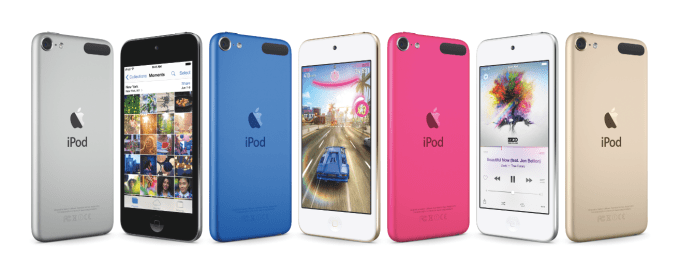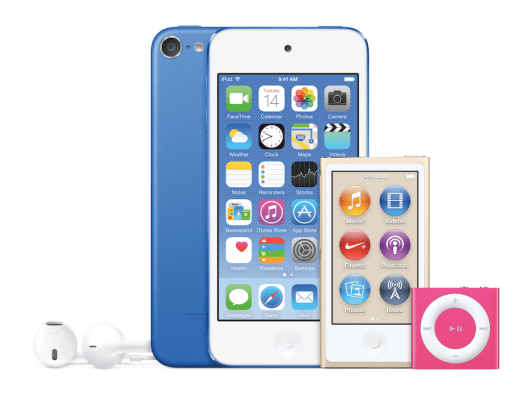There are indications that Apple still believes that the iPod touch fits a certain niche, and those come in the form of a smattering of hardware upgrades. The refreshed models feature a more powerful processor, better camera hardware and imaging software and a focus on the iPod as a gaming and photography platform. Updated with benchmarks below.
The Refresh
New iPods generally means new colors, and this is no exception. The new iPod touch models will come in silver, space gray, (Product)red, pink, blue and gold. The new colors in the batch are the pink, blue and gold. Those new colors also appear in the nano and shuffle models, in addition to the larger touch. The iPod nano and shuffle models remain unchanged in features and price.
The new iPod touch models are being upgraded internally to the A8 processor used in the iPhone 6, which is a welcome upgrade from the former A5 processor. It’s also quite the leap, as iPod touch processors have generally lagged a generation behind the current iPhone (though they have been in parity before). It speaks to the power efficiency of the A8 that it’s even a viable choice in a device with a much lower volume battery. No word on what the processor is clocked at, so it’s up in the air whether it’s being pushed to its maximum.
The importance of the switch, of course, is that Apple is working to get all of its touch devices running 64-bit processors. The last device standing at this point is the iPhone 5c, which runs on an A6 chip. That’s key for several reasons, including cost effectiveness and performance, but also because Apple can now comfortably require that all apps built for the App Store be compatible with 64-bit architecture.
The new processor also supports Metal, Apple’s low-level framework that allows game developers direct access to the graphics processor. This results in a jump of about 10x in speed for gaming, along with a 6x jump in CPU.
Along with the A8, the new iPod touch also gets Apple’s M8 motion co-processor. This is the chip that allows your device to record motion and activity for recording in the Health database and elsewhere — while using far less battery than keeping the main processor alive. The new iPod also gets 801.11ac wireless support.
The overall battery life in the new iPod touch is staying the same.

Photopod
The iPod touch is also getting a new rear-facing camera and some front-facing software updates.
The new rear camera is 8 megapixel and is paired with a fresh image-processing chip. It’s not clear whether the ISP is the same as the one in the iPhone 6, but it’s definitely upgraded. The new pipeline processing allows for a bunch of the features of the 6 to come to the iPod touch. Burst mode is now included for the rear camera at 10fps. You can shoot video with 120fps slo-mo. It has cinematic stabilization in video mode, as well. The face selection algorithms have also been improved.
The front-facing camera isn’t changing in resolution, but it is getting larger pixel pitch, making it better for those low-light selfies. HDR stills and video are now available in the front-facing camera, as is burst mode.
The new iPod touch models will still begin at $199 for 16GB. 32GB $249, 64GB $299 and they’re adding a new 128GB model at $399. Note that the jump between 16GB and 32GB is fairly small, which is welcome.
What Is iPod?
Though the massive rise of the iPhone have bitten away at sales of the iPod touch, there is still a business here. Apple, likely to change the narrative around the “fall of the iPod” — which allows analysts to look at iPod numbers in a vacuum — no longer reports their sales figures separately. Though a decline, the ‘accessories and iPod’ category still accounted for $2.68 billion in revenue in Q1 2015.
The shaping and refining of the iPod touch over the last couple of years has spelled out what Apple feels the iPod is still great for. It’s no longer just a music player; it’s a gaming platform and a camera. This usage has played out right in front of me, as my daughter uses her touch as a (prolific) photography tool, shooting pictures of herself, our dog, us, the back of our car seat…you get the picture. There’s a case to be made that the iPod touch could be positioned as a standalone camera, much in the way that the original iPod was positioned as a media player.
The iPod touch as the new point-and-shoot.
A camera, of course, that also plays thousands of games.
The iPod touch as the new Gameboy.
Whatever the use case, it’s pretty clear that the iPod touch is not the new iPod. When everything plays music, a dedicated player makes less and less sense.
Update: We’ve got some of the new iPods here to play with and we ran an initial benchmark on the iPod touch. The processor appears to be running at 1.10GHz per core, vs the iPhone 6’s A8 processor, which clocks in at 1.39GHz. The Geekbench scores clock in at 1379 and 2440 right out of the box with as much idle state as I could manage. This means that the iPod touch A8 processor is under-clocked slightly from the iPhone 6, which is not surprising given the battery constraints I mentioned above. It also appears to have 1GB of RAM.
[gallery ids="1183323,1183324,1183325"]
